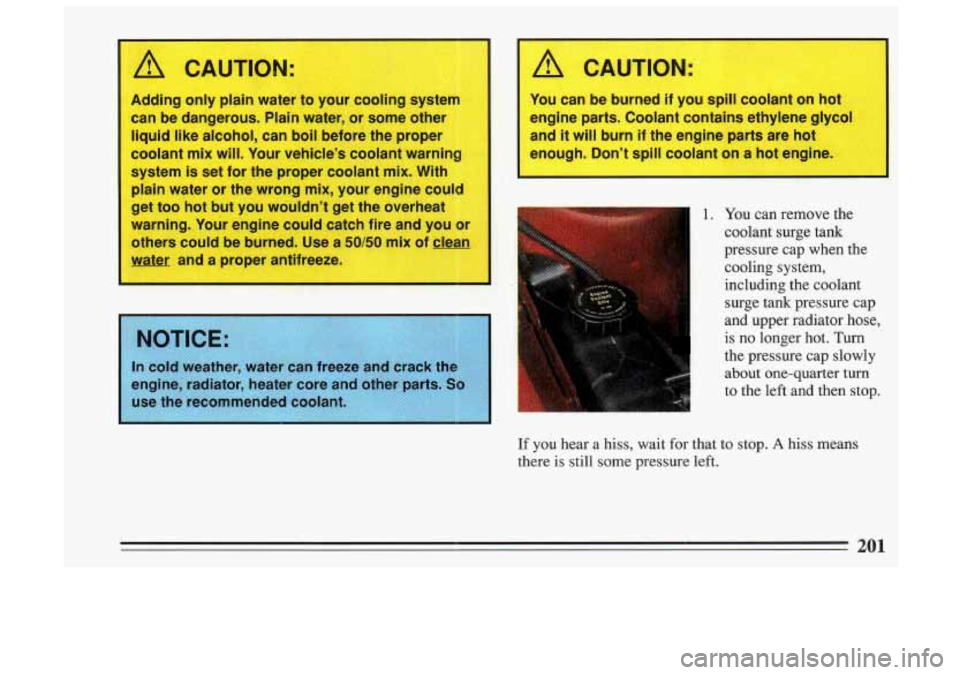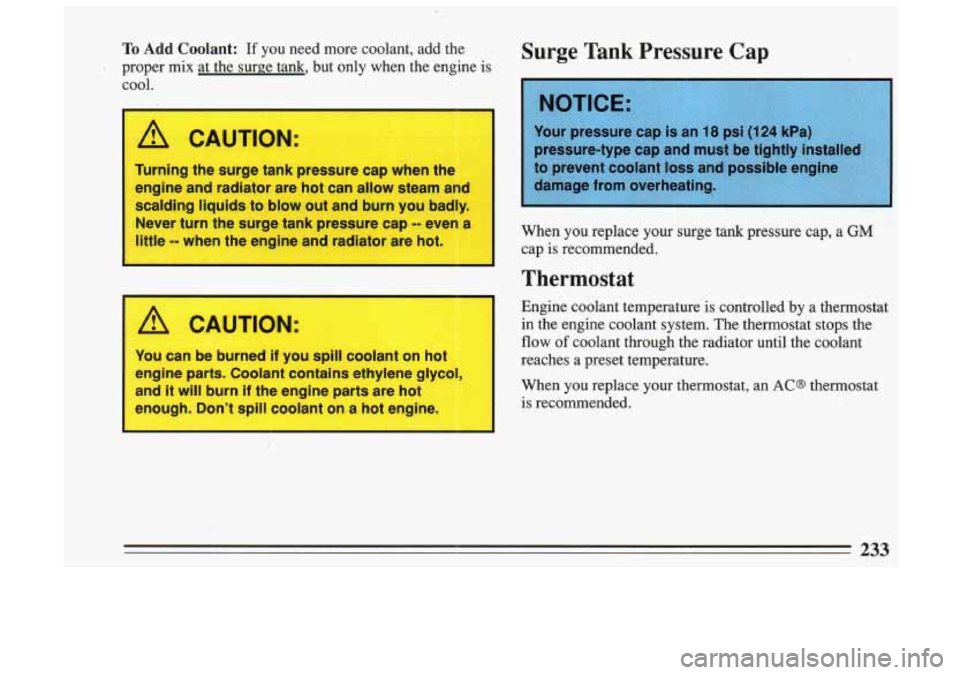Page 202 of 306

1
A CAUTION':
Adding only plain water to your cooling system
can be dangerous. Plain water, or some lother
liquid li~ke alcohol, can boil before tihe proper
coolant
mix will. Your whicl'e's CoOilant warning
You can1 be burned if you spill coolant on hot ,,
engilne ~parts. Coolaint contains ethylene glycol
and lit wil~il burn if the enlgine parts are ,hot
enough. hn't spill coolant
on a hot engine. I
system is set for the proper coolant mix. With
plain water or the wron.g, mix, your engi'ne could8 1
get too h,ot but you wouldn't get thie overheat
warning. Your engine could catclh fire and
you or
others could
be burned. Use ;a 50/50 mix of clean
water and a proper antifreeze.
1
I
1-
1. You can remove the
coolant surge tank
pressure cap when the
cooling system,
including the coolant
surge
tank pressure cap
and upper radiator hose,
is no longer hot. Turn
the pressure cap slowly
i about one-quarter turn
1 to the left and then stop. I
If you hear a hiss, wait for that to stop. A hiss means
there is still some pressure left.
201
Page 204 of 306
4.
5. By this time, the coolant level inside the coolant
surge tank may be lower. If the level is lower, add
more of the proper mix to the coolant surge tank
until the level reaches the split line formed by the
black and white part of the tank.
With the coolant surge tank pressur\e cap off, start the
engine and let it run until you can feel the upper
radiator hose getting hot. Watch out for the engine
6. Then replace the
pressure cap. Be sure
the pressure cap is tight.
fan.
203
Page 234 of 306

To Add Coolant: If you need more coolant, add the
proper mix at the surge tank, but only when the engine is cool.
A CAUTION:
Turning the surge tank pressure cap when the
engine and radiator are hot can allow steam and
scalding liquids to blow out and burn you badly.
Never turn the surge tank pressure cap
-- even a
little
-- when the engine and radiator are hot.
I
I
1 A CAUTION:
You can be burned if you spill coolant on hot
engine parts. Coolant contains ethylene glycol,
and
it will burn if the engine parts are hot
enough. Don’t spill coolant
on a hot engine.
1
Surge Tank Pressure Cap
pressure-type cap and must be tightly installed
When you replace your surge tank pressure cap, a GM
cap is recommended.
Thermostat
Engine coolant temperature is controlled by a thermostat
in the engine coolant system. The thermostat stops the
flow of coolant through the radiator until the coolant
reaches a preset temperature.
When you replace your thermostat, an
ACS thermostat
is recommended.
233
Page 276 of 306

Inspect hoses and replace if they are cracked,
swollen or deteriorated. Tighten screw-type hose
clamps. Clean the outside of the~radiator and air
conditioning condenser. Wash the pressure cap and
neck.
To help ensure proper operation, we recommend a
pressure test
of both the cooling system and the
pressure cap.
7. Transaxle Service -- Change both the fluid and
filter every
15,000 miles (25 000 km) if the vehicle
is mainly driven under one or more of these
conditions:
0 In heavy city traffic where the outside
temperature regularly reaches
90 F (32 C) or
higher.
0 In hilly or mountainous terrain.
When doing frequent trailer towing. (With some
models, you shouldn’t ever tow a trailer. See
“Towing a Trailer” in the Index.)
Uses such as found in taxi, police car or delivery
service. If you
do’ not use your vehicle under any of these
conditions, change both the fluid and filter every
100,000 miles (160 000 km).
8. Spark Plug Replacement* -- Replace spark plugs
with the proper type. See “Specifications Chart” in
the Index.
9. Spark Plug Wire Inspection (3.3L Code N engine
only)*?
-- Inspect for burns, cracks or other
damage. Check the boot fit at the coils and at the
spark plugs. Replace wires as needed.
10. Air Cleaner Filter Replacement* -- Replace every
30,000 miles
(50 000 km) or more often under dusty
conditions. Ask your dealer for the proper
replacement intervals for your driving conditions.
11. Fuel Tank, Cap and Lines Inspection”? -- Inspect
fuel
tank, cap and lines (including fuel rails and
injection assembly) for damage or leaks. Inspect fuel
cap gasket for an even filler neck imprint or any
damage. Replace parts as needed. Periodic
replacement of the fuel filter is not required.
* An Emission Control Service.
The
U.S. Environmental Protection Agency has determined that the failure to perform this maintenance item will not nullify the emission warranty or limit recall liability prior to the completion of vehicle
useful life. General Motors, however, urges that all recommended maintenance services be performed at the indicated intervals and the maintenance be recorded in “Section EMaintenance Record”.